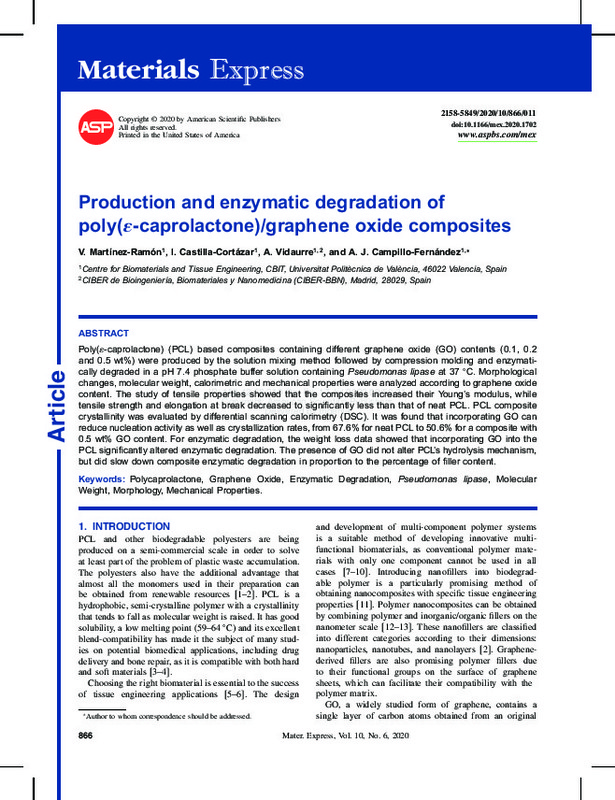

Listar por palabra clave "Enzymatic degradation"
RiuNet: Repositorio Institucional de la Universidad Politécnica de Valencia
- RiuNet repositorio UPV
- :
- Listar por palabra clave
JavaScript is disabled for your browser. Some features of this site may not work without it.
Buscar en RiuNet
Listar
Mi cuenta
Ayuda RiuNet
Admin. UPV
Listar por palabra clave "Enzymatic degradation"
Mostrando ítems 1-8 de 8
-
Pau Balaguer, M.; Gomez-Estaca, Joaquin; Gavara Clemente, Rafael; Hernandez-Munoz, Pilar (American Chemical Society, 2011-12-28)[EN] The aim of this work has been to study the modification of gliadin films with cinnamaldehyde as a potential crosslinker agent. The molecular weight profile and cross-linking density showed that cinnamaldehyde increased ...
-
Fernández, Juan Manuel; Gisela Oberti, Tamara; Vikingsson, Line; Gómez Ribelles, José Luís; Cortizo, Ana (Elsevier, 2016-08)[EN] The aim of this study is to show that introducing a small fraction of hydrophilic groups into a hydrophobic polyester favor the macrophage activity by accelerating the degradation action in aqueous media. It is also ...
-
Valdés, Arantzazu; Fenollar Gimeno, Octavio Ángel; Beltrán, Ana; Balart Gimeno, Rafael Antonio; Fortunati, Elena; Kenny, Jose Mª; Garrigos, María Carmen (Elsevier, 2016-10)[EN] Reinforced poly(e-caprolactone) (PCL)/almond skin (AS) biocomposites were prepared by extrusion and injection moulding at different AS contents (0, 10, 20, 30 wt%) in order to revalorize this agricultural residue. AS ...
-
Trujillo-Muñoz, Sara; Seow, Melanie; Lueckgen, Aline; Salmerón Sánchez, Manuel; Cipitria, Amaia (MDPI AG, 2021-02)[EN] Alginate is a polysaccharide used extensively in biomedical applications due to its biocompatibility and suitability for hydrogel fabrication using mild reaction chemistries. Though alginate has commonly been crosslinked ...
-
Wcislek, Aleksandra; Sonseca Olalla, Agueda; McClain, Andrew; Piegat, Agnieszka; Sobolewski, Peter; Puskas, Judit; El Fray, Miroslawa (MDPI AG, 2018-06)[EN] Biodegradable polymers are an active area of investigation, particularly ones that can be produced from sustainable, biobased monomers, such as copolymers of poly(butylene succinate) (PBS). In this study, we examine ...
-
Perez Garnes, Manuel; Monleón Pradas, Manuel (Elsevier, 2017)[EN] Semi-biodegradable copolymer networks derived from two immiscible components, a hyaluronan derivative (methacrylated hyaluronan) and poly(ethyl acrylate), have been developed for soft tissue engineering applications. ...
-
García García, Daniel; Ferri Azor, José Miguel; Boronat Vitoria, Teodomiro; López-Martínez, Juan; Balart Gimeno, Rafael Antonio (Springer Verlag (Germany), 2016-12)[EN] The present work is focused on the development of binary blends from poly(hydroxybutyrate) (PHB) and poly(caprolactone) (PCL). Miscibility, mechanical and thermal properties as well as blends morphology are evaluated ...
-
Martínez-Ramón, V.; Castilla Cortázar, María Isabel Cecilia; Vidaurre, Ana; CAMPILLO FERNANDEZ, ALBERTO JOSE (American Scientific Publishers, 2020-06)[EN] Poly(epsilon-caprolactone) (PCL) based composites containing different graphene oxide (GO) contents (0.1, 0.2 and 0.5 wt%) were produced by the solution mixing method followed by compression molding and enzymatically ...
Mostrando ítems 1-8 de 8

Universitat Politècnica de València. Unidad de Documentación Científica de la Biblioteca (+34) 96 387 70 85 · RiuNet@bib.upv.es







